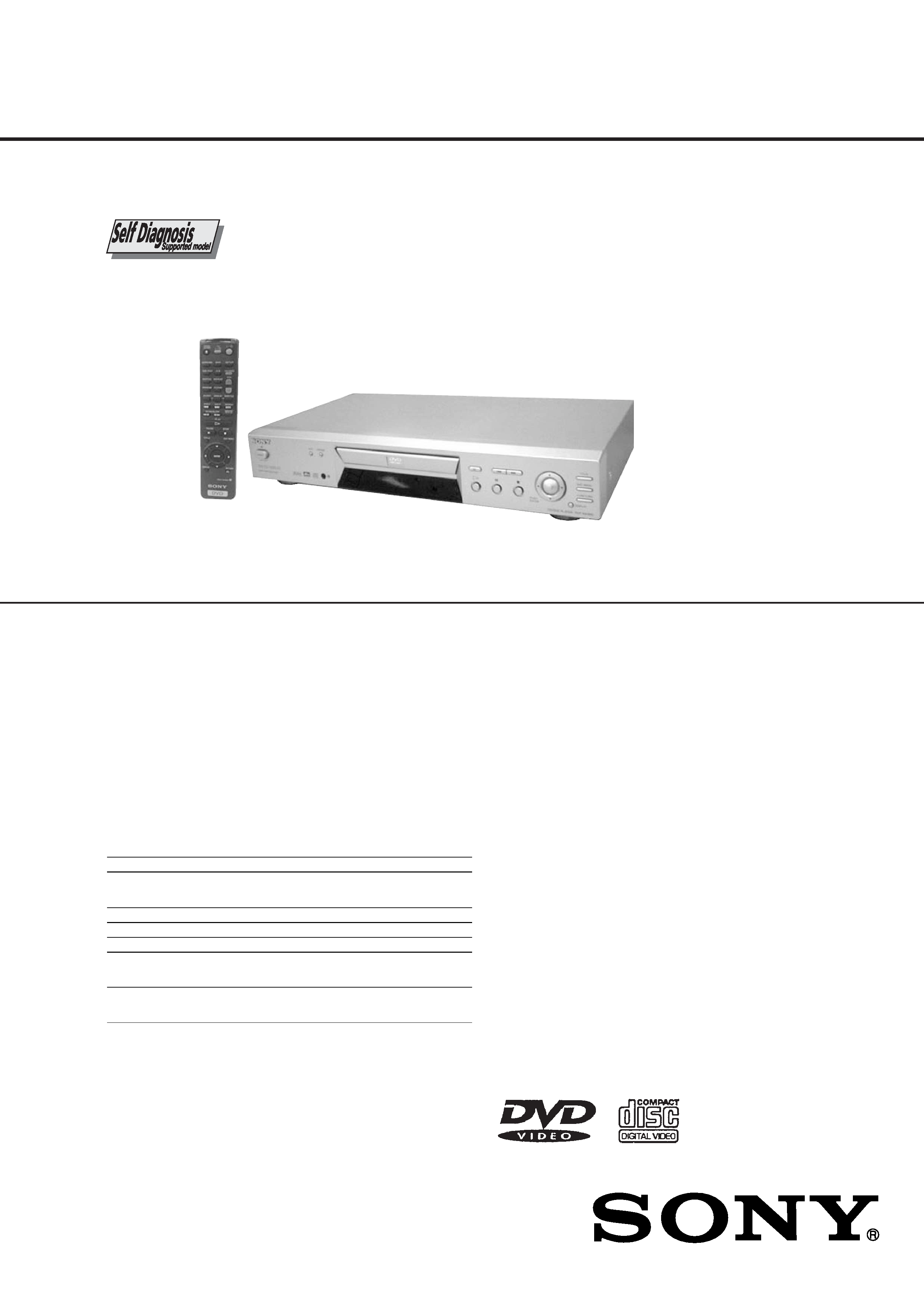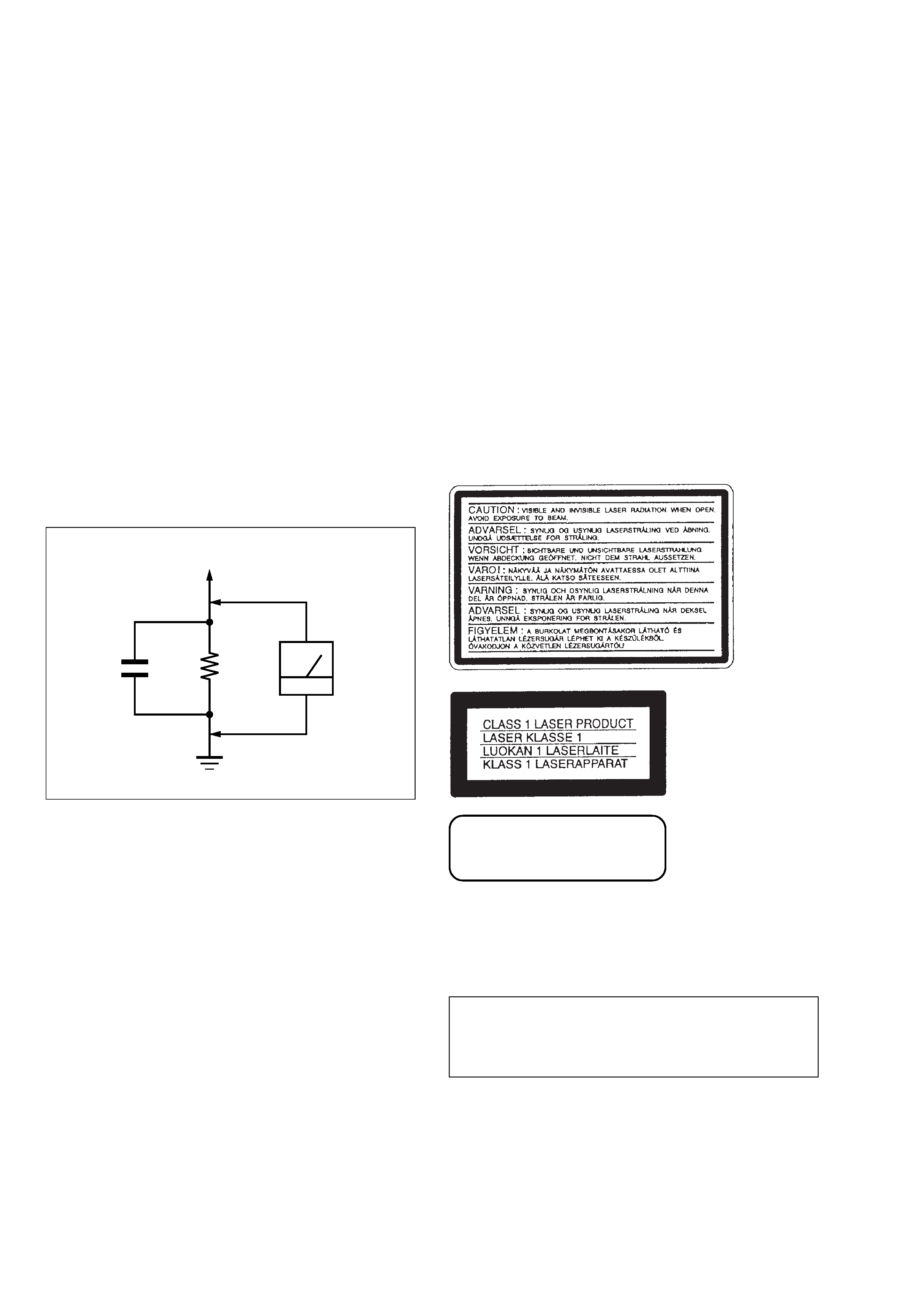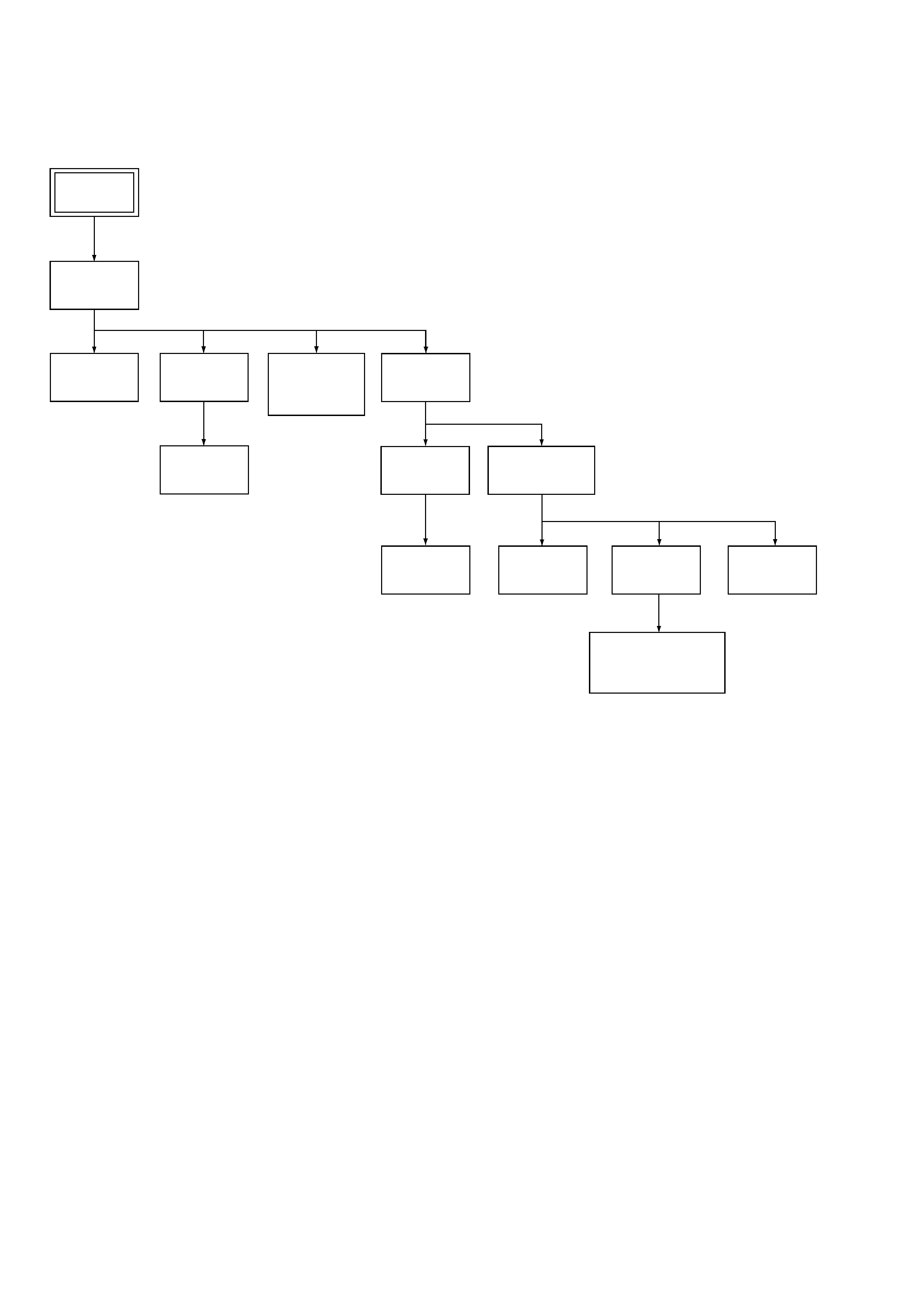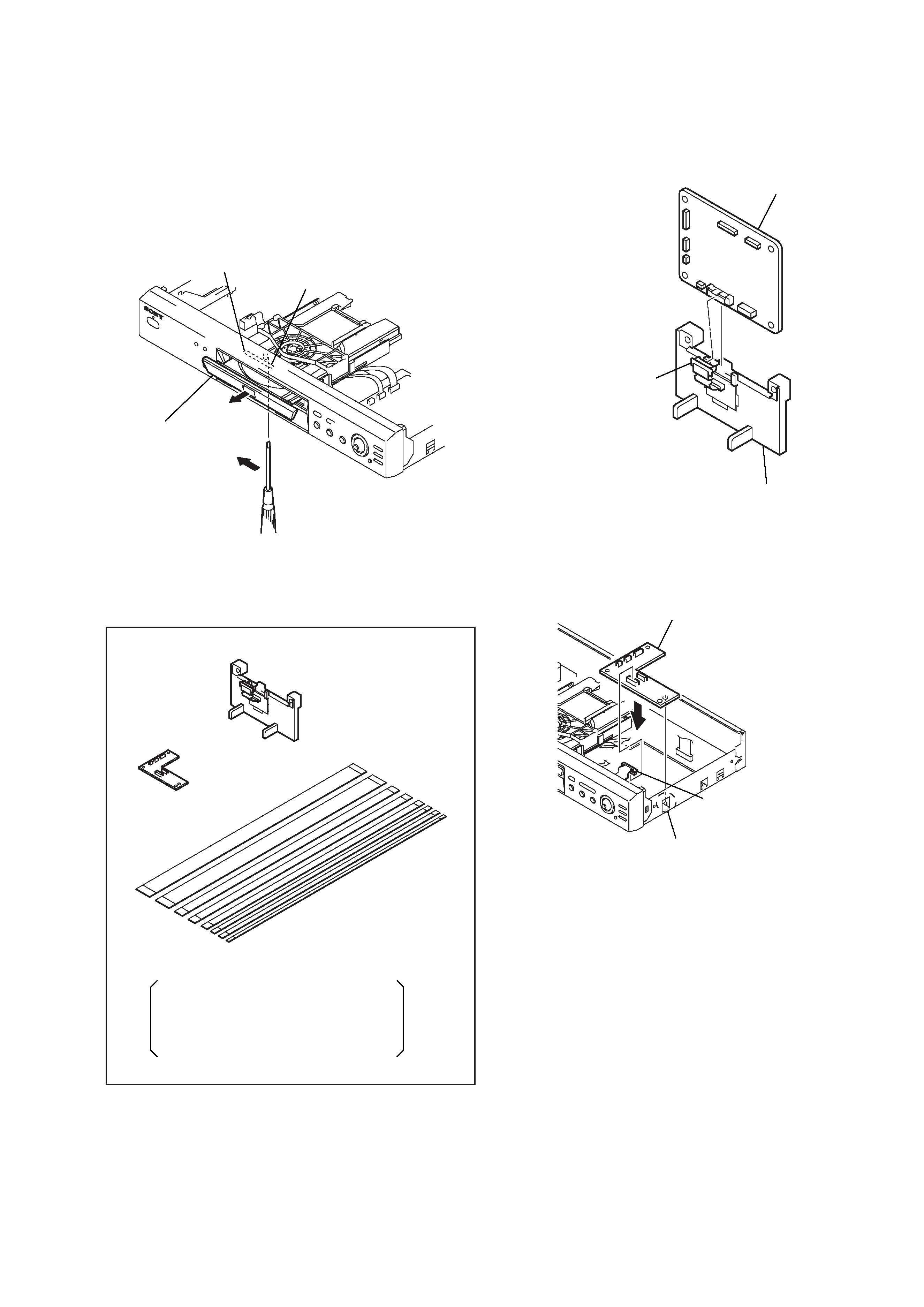
SERVICE MANUAL
US Model
Canadian Model
AEP Model
UK Model
E Model
Australian Model
PX Model
Russian Model
Brazil Model
Mexico Model
Argentina Model
Malaysia Model
Saudi Arabia Model
Hong Kong Model
Korea Model
Singapore Model
Taiwan Model
CD/DVD PLAYER
DVP-NS300
RMT-D126A/D126E/D126P
SPECIFICATIONS
· Audio/video cord (pinplug × 3 y pinplug × 3) (1)
· Remote commander (remote) RMT-D126A (1) (US, AR, BR, CND, E32, MX, PX)
RMT-D126E (1) (AUS, E12, EA, ME)
RMT-D126P (1) (AEP, UK, RUS)
· Size AA (R6) batteries (2)
· A
· Abbreviation
AR
AUS
BR
CND
E12
E32
EA
HK
plug a
: Argentina
: Australian
: Brazilian
: Canadian
: 220-240 V AC Area in E
: 110-240 V AC Area in E
: Saudi Arabia
: Hong Kong
KR
ME
MX
RUS
SP
TW
: Korea
: Middle East
: Mexican
: Russian
: Singapore
: Taiwan
daptor is included with some models.
System
Laser
Semiconductor laser
Signal format system
NT
PAL (EXCEPT US, AR, BR, CND, E32, MX, PX)
SC
Audio characteristics
Frequency response
DVD (PCM 96 kHz): 2 Hz to 44 kHz (
±1.0 dB)
DVD (PCM 48 kHz): 2 Hz to 22 kHz (
±0.5 dB)
CD: 2 Hz to 20 kHz (
±0.5 dB)
Signal-to-noise ratio (S/N ratio)
115 dB (LINE OUT L/R (AUDIO) jacks only)
Harmonic distortion
0.003 %
Dynamic range
DVD: 103 dB
CD: 99 dB
Wow and flutter
Less than detected value (
±0.001% W PEAK)
The signals from LINE OUT L/R (AUDIO) jacks are measured. When you play PCM sound tracks with
a 96 kHz sampling frequency, the output signals from the DIGITAL OUT (COAXIAL and OPTICAL) jacks
are converted to 48 kHz sampling frequency.
Outputs
General
Power requirements
120V AC, 60 Hz (US, CND, MX)
110V AC, 60 Hz (TW)
110 to 240V AC, 50/60 Hz (BR, E32, PX)
220V AC, 50/60 Hz (AR, EA, HK, KR)
220 to 240V AC, 50/60 Hz (AEP, UK, AUS, E12, ME, RUS, SP)
Power consumption
12 W
See page 3 for further information.
Dimensions (approx.)
430
× 74 × 256 mm (17
× 3 × 10 1/8 in.) (width/height/depth) incl.
projecting parts
Mass (approx.)
2.7 kg (5 lb)
Operating temperature
5
°C to 35 °C (41 °F to 95 °F)
Operating humidity
25 % to 80 %
Supplied accessories
Specifications and design are subject to change without notice.
Jack name
Jack type
Maximum output level
Load impedance
DI
(EXCEPT AEP, UK, RUS)
GITAL OUT (OPTICAL)
Optical
output
jack
-18 dBm
Wave length: 660 nm
DIGITAL OUT (COAXIAL) Phono jack
0.5 Vp-p
75 ohms terminated
LINE OUT (AUDIO)
Phono jack
2 Vrms (50 kilohms)
Over 10 kilohms
LINE OUT (VIDEO)
Phono jack
1.0 Vp-p
75 ohms, sync negative
S VIDEO OUT
4-pin mini DIN
Luminance signal: 1.0 Vp-p
0.3 Vp-p (PAL)
75 ohms, sync negative
Colour signal: 0.286 Vp-p (NTSC)
75 ohms terminated
COMPONENT
(EXCEPT AEP, UK, RUS)
Phono jack
Y: 1.0 Vp-p
75 ohms, sync negative
VIDEO OUT (Y, PB, PR)PB, PR: 0.7 Vp-p
75 ohms terminated
Photo: Titanium gray type

2
WARNING!!
WHEN SERVICING, DO NOT APPROACH THE LASER
EXIT WITH THE EYE TOO CLOSELY. IN CASE IT IS
NECESSARY TO CONFIRM LASER BEAM EMISSION,
BE SURE TO OBSERVE FROM A DISTANCE OF
MORE THAN 25 cm FROM THE SURFACE OF THE
OBJECTIVE LENS ON THE OPTICAL PICK-UP BLOCK.
CAUTION
Use of controls or adjustments or performance of procedures
other than those specified herein may result in hazardous ra-
diation exposure.
ATTENTION AU COMPOSANT AYANT RAPPORT
À LA SÉCURITÉ!
LES COMPOSANTS IDENTIFIÉS PAR UNE MARQUE 0
SUR LES DIAGRAMMES SCHÉMATIQUES ET LA LISTE
DES PIÈCES SONT CRITIQUES POUR LA SÉCURITÉ
DE FONCTIONNEMENT. NE REMPLACER CES COM-
POSANTS QUE PAR DES PIÈCES SONY DONT LES
NUMÉROS SONT DONNÉS DANS CE MANUEL OU
DANS LES SUPPLÉMENTS PUBLIÉS PAR SONY.
SAFETY-RELATED COMPONENT WARNING!!
COMPONENTS IDENTIFIED BY MARK 0 OR DOTTED
LINE WITH MARK 0 ON THE SCHEMATIC DIAGRAMS
AND IN THE PARTS LIST ARE CRITICAL TO SAFE
OPERATION. REPLACE THESE COMPONENTS WITH
SONY PARTS WHOSE PART NUMBERS APPEAR AS
SHOWN IN THIS MANUAL OR IN SUPPLEMENTS PUB-
LISHED BY SONY.
CAUTION:
The use of optical instrument with this product will increase eye
hazard.
Fig. A.
Using an AC voltmeter to check AC leakage.
1.5 k
0.15
µF
AC
voltmeter
(0.75 V)
To Exposed Metal
Parts on Set
Earth Ground
LEAKAGE TEST
The AC leakage from any exposed metal part to earth ground
and from all exposed metal parts to any exposed metal part having
a return to chassis, must not exceed 0.5 mA (500 microamperes).
Leakage current can be measured by any one of three methods.
1. A commercial leakage tester, such as the Simpson 229 or RCA
WT-540A. Follow the manufacturers' instructions to use these
instruments.
2. A battery-operated AC milliammeter. The Data Precision 245
digital multimeter is suitable for this job.
3. Measuring the voltage drop across a resistor by means of a
VOM or battery-operated AC voltmeter. The "limit" indica-
tion is 0.75V, so analog meters must have an accurate low-
voltage scale. The Simpson 250 and Sanwa SH-63Trd are ex-
amples of a passive VOM that is suitable. Nearly all battery
operated digital multimeters that have a 2V AC range are suit-
able. (See Fig. A)
1. Check the area of your repair for unsoldered or poorly-sol-
dered connections. Check the entire board surface for solder
splashes and bridges.
2. Check the interboard wiring to ensure that no wires are
"pinched" or contact high-wattage resistors.
3. Look for unauthorized replacement parts, particularly transis-
tors, that were installed during a previous repair. Point them
out to the customer and recommend their replacement.
4. Look for parts which, though functioning, show obvious signs
of deterioration. Point them out to the customer and recom-
mend their replacement.
5. Check the line cord for cracks and abrasion. Recommend the
replacement of any such line cord to the customer.
6. Check the B+ voltage to see it is at the values specified.
7. Check the antenna terminals, metal trim, "metallized" knobs,
screws, and all other exposed metal parts for AC leakage.
Check leakage as described below.
SAFETY CHECK-OUT
After correcting the original service problem, perform the following
safety checks before releasing the set to the customer:
CLASS 3B LASER
LUOKAN 3B LASER
LASERKLASS 3B

3
TABLE OF CONTENTS
Section
Title
Page
Section
Title
Page
Service Note ............................................................................ 4
1.
GENERAL
Getting Started .............................................................. 1-3
Hookups ........................................................................ 1-3
Playing Discs ................................................................. 1-6
Searching for a Scene ................................................... 1-8
Viewing Information About the Disc .............................. 1-9
Sound Adjustments ....................................................... 1-10
Enjoying Movies ............................................................ 1-10
Using Various Additional Functions .............................. 1-11
Settings and Adjustments ............................................. 1-13
Additional Information ................................................... 1-14
2.
DISASSEMBLY
2-1.
Case Removal ............................................................... 2-1
2-2.
MB-98 Board Removal .................................................. 2-1
2-3.
ER-14 Board Removal (AEP, UK, RUS) ....................... 2-1
2-4.
Rear Panel Removal ..................................................... 2-1
2-5.
AV-56 Board Removal ................................................... 2-2
2-6.
Tray Cover Removal ...................................................... 2-2
2-7.
Front Panel Removal ..................................................... 2-2
2-8.
Power Block Removal ................................................... 2-2
2-9.
Mechanism Deck Removal ............................................ 2-3
2-10. Tray Removal ................................................................. 2-3
2-11. Loading Motor (M001), MS-81 Board Removal ............ 2-3
2-12. Optical Pick-up Removal ............................................... 2-3
2-13. IF-80 Board Removal .................................................... 2-4
2-14. Internal Views ................................................................ 2-5
2-15. Circuit Boards Location ................................................. 2-6
3.
BLOCK DIAGRAMS
3-1.
Overall Block Diagram ................................................... 3-1
3-2.
RF/Servo Block Diagram ............................................... 3-3
3-3.
Signal Processor Block Diagram .................................. 3-5
3-4.
System Control Block Diagram ..................................... 3-7
3-5.
Video Block Diagram ..................................................... 3-9
3-6.
Audio Block Diagram ..................................................... 3-11
3-7.
Interface Control Block Diagram ................................... 3-13
3-8.
Power 1 Block Diagram ................................................. 3-15
3-9.
Power 2 Block Diagram ................................................. 3-17
3-10. Power 3 Block Diagram ................................................. 3-19
4.
PRINTED WIRING BOARDS AND SCHEMATIC
DIAGRAMS
4-1.
Frame Schematic Diagram ............................................ 4-3
4-2.
Printed Wiring Boards and Schematic Diagrams ......... 4-5
MS-81 (LOADING) Printed Wiring Board and
Schematic Diagram ....................................................... 4-5
MB-98 Printed Wiring Board ......................................... 4-7
MB-98 (RF AMP, SERVO) Schematic Diagram ............ 4-11
MB-98 (ARP, SERVO DSP) Schematic Diagram .......... 4-13
MB-98 (AV DECODER) Schematic Diagram ................ 4-15
MB-98 (BNR) Schematic Diagram ................................ 4-17
MB-98 (DRIVE) Schematic Diagram ............................ 4-19
MB-98 (SYSTEM CONTROL)
Schematic Diagram ....................................................... 4-21
MB-98 (CLOCK GENERATOR)
Schematic Diagram ....................................................... 4-23
MB-98 (AUDIO DSP, D/A CONVERTER)
Schematic Diagram ....................................................... 4-25
AV-56 Printed Wiring Board .......................................... 4-29
AV-56 (VIDEO BUFFER) Schematic Diagram .............. 4-31
AV-56 (AUDIO AMP) Schematic Diagram .................... 4-33
IF-80 Printed Wiring Board ........................................... 4-35
IF-80 (IF CON) Schematic Diagram ............................. 4-37
ER-14 Printed Wiring Board (AEP, UK, RUS) ............... 4-39
ER-14 (EURO AV) Schematic Diagram
(AEP, UK, RUS) ............................................................. 4-41
HS13S0E Printed Wiring Board (AEP, UK, AR, AUS,
E12, EA, HK, KR, ME, RUS, SP) .................................. 4-43
HS13S0E Schematic Diagram (AEP, UK, AR, AUS,
E12, EA, HK, KR, ME, RUS, SP) .................................. 4-45
HS13S0F Printed Wiring Board (BR, E32, PX) ............ 4-47
HS13S0F Schematic Diagram (BR, E32, PX) .............. 4-49
HS13S0U Printed Wiring Board (US, CND, MX, TW) .. 4-51
HS13S0U Schematic Diagram (US, CND, MX, TW) .... 4-53
TOP-244U Printed Wiring Board (US, CND, MX) ......... 4-55
TOP-244U Schematic Diagram (US, CND, MX) ........... 4-57
5.
IC PIN FUNCTION DESCRIPTION
5-1.
System Control Pin Function
(MB-98 Board IC103) .................................................... 5-1
6.
TEST MODE
6-1.
General Description ...................................................... 6-1
6-2.
Starting Test Mode ........................................................ 6-1
6-3.
Syscon Diagnosis .......................................................... 6-1
6-4.
Drive Auto Adjustment .................................................. 6-5
6-5.
Drive Manual Operation ................................................ 6-7
6-6.
Mecha Aging ................................................................. 6-10
6-7.
Emergency History ........................................................ 6-10
6-8.
Version Information ....................................................... 6-11
6-9.
Video Level Adjustment ................................................ 6-11
6-10. IF CON Self Diagnostic Function .................................. 6-11
6-11. Troubleshooting ............................................................. 6-18
7.
ELECTRICAL ADJUSTMENT
7-1.
Power Supply Check ..................................................... 7-1
1.
HS13S0E/HS13S0F/HS13S0U/TOP-244U Boards ...... 7-1
7-2.
Adjustment of Video System ......................................... 7-2
1.
Video Level Adjustment ................................................ 7-2
2.
Checking S Video Output S-Y ....................................... 7-2
3.
Checking S Video Output S-C ....................................... 7-2
4.
Checking Component Video Output Y .......................... 7-2
5.
Checking Component Video Output B-Y ...................... 7-3
6.
Checking Component Video Output R-Y ...................... 7-3
7.
Checking RGB Output R ............................................... 7-3
8.
Checking RGB Output G ............................................... 7-3
9.
Checking RGB Output B ............................................... 7-4
7-3.
Adjustment Related Parts Arrangement ....................... 7-6
8.
REPAIR PARTS LIST
8-1.
Exploded Views ............................................................. 8-1
8-1-1. Case Assembly ........................................................ 8-1
8-1-2. Chassis Assembly .................................................... 8-3
8-1-3. Mechanism Deck Assembly ..................................... 8-5
8-2.
Electrical Parts List ....................................................... 8-6
·
Abbreviation
AR
: Argentina
AUS : Australian
BR
: Brazilian
CND : Canadian
E12
: 220-240 V AC Area in E
E32
: 110-240 V AC Area in E
EA
: Saudi Arabia
HK
: Hong Kong
KR
: Korea
ME
: Middle East
MX
: Mexican
RUS : Russian
SP
: Singapore
TW
: Taiwan

4
SERVICE NOTE
1.
DISASSEMBLY
· This set can be disassembled in the order shown below.
Set
Case
(Page 2-1)
Tray Cover
(Page 2-2)
Front Panel
(Page 2-2)
Tray
(Page 2-3)
Loading Motor (M001),
MS-81 Board
(Page 2-3)
Opticl Pick-up
(Page 2-3)
Power Block
(Page 2-2)
Mechanism Deck
(Page 2-3)
MB-98 Board
(Page 2-1)
ER-14
(AEP, UK, RU)
(Page 2-1)
IF-80 board
(Page 2-4)
AV-56 Board
(Page 2-2)
Rear Panel
(Page 2-1)

5
1) Remove the case from the set. (Refer to 2-1)
2) Remove the MB-98 board. (Refer to 2-1)
3) Set the stand (with CK-106 board) as shown in Fig. 2.
Fig. 2
4) Set the Jig A board as shown in Fig. 3.
Fig. 3
2.
DISC REMOVAL PROCEDURE
(at POWER OFF)
1) Insert a tapering driver into the aperture of the unit bottom,
and move the lever of chuck cam in the direction of the arrow
A
. (See Fig. 1)
2) Draw out the tray in the direction of the arrow B, and remove
a disc. (See Fig. 1)
Fig. 1
3.
HOW TO SERVICE MB-98 BOARD
· Jig (J-6090-107-A) Extension cable
CK-105 board
Stand
(with CK-106 Board)
Eight flexible flat cables
FFC 5P, FFC 9P, FFC 15P, FFC26P,
FFC 9P (DVP-NS500P/NS700P),
FFC 15P (DVP-NS400D),
FFC 25P (EXCEPT DVP-NS300 J model),
FFC 29P (DVP-NS300 J model)
1
MB-98 board
2
Stand
(with CK-106 board)
3
Connector (CN101)
Tray
Lever of chuck cam
Aperture
B
A
4
Connector (CN109)
1
CK-105 board
3
Claw
2
